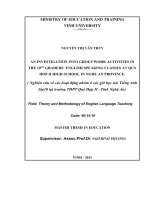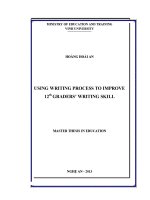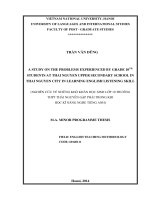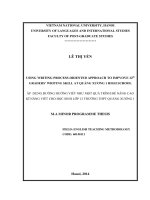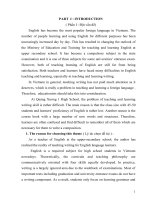using role play to improve 10th graders’ speaking skill at a mountainous upper secondary school in binh thuan province
Bạn đang xem bản rút gọn của tài liệu. Xem và tải ngay bản đầy đủ của tài liệu tại đây (471.25 KB, 78 trang )
VIETNAM ACADEMY OF SOCIAL SCIENCES
GRADUATE ACADEMY OF SOCIAL SCIENCES
Trần Thị Linh Sơn
USING ROLE PLAY TO IMPROVE 10
TH
GRADERS’
SPEAKING SKILL AT A MOUNTAINOUS UPPER
SECONDARY SCHOOL IN BINH THUAN PROVINCE
MA THESIS IN ENGLISH LANGUAGE
HO CHI MINH CITY, 2020
VIETNAM ACADEMY OF SOCIAL SCIENCES
GRADUATE ACADEMY OF SOCIAL SCIENCES
Trần Thị Linh Sơn
USING ROLE PLAY TO IMPROVE 10
TH
GRADERS’
SPEAKING SKILL AT A MOUNTAINOUS UPPER
SECONDARY SCHOOL IN BINH THUAN PROVINCE
Field: English Language
Code: 8220201
Supervisor: Lê Hương Hoa, Ph.D.
HO CHI MINH CITY, 2020
DECLARATION BY THE AUTHOR
Honestly speaking, I declare that this thesis “Using role play to
improve 10th graders’ speaking skill at a mountainous upper secondary
school in Bình Thuận province”, which I have written, is not a plagiarism,
except those cited in the quotation and the source of which is listed on the
bibliography.
Author’s signature
Trần Thị Linh Sơn
Approved by
SUPERVISOR
Lê Hương Hoa, Ph.D.
Date: ……………………
i
ACKNOWLEDGEMENTS
During the process of carrying out this thesis, I have received a larger
amount of contribution and support from many people.
First of all, I would like to express my gratitude to my supervisor, Dr.
Lê Hương Hoa, who always gives useful advices and her enthusiasm to finish
this thesis.
I also address my deepest gratitude to Dr. Đặng Nguyên Giang, as The
Head of the English Department, for his support and encouragement in the
process of finishing this thesis.
Next, I would like to thank the headmaster of Đức Linh High school,
Phan Văn Pháp, who has allowed and supported me to complete the Master
thesis.
Last but not at least, I would like fly my gratitude to my family, my
friends, my colleagues and my students who have given me constant support
during the completion of the study.
ii
TABLE OF CONTENTS
DECLARATION BY THE AUTHOR ..............................................................
i
ACKNOWLEDGEMENTS .............................................................................. ii
ABSTRACT ..................................................................................................... vi
LIST OF TABLES .......................................................................................... vii
LIST OF ABBREVIATIONS ........................................................................ viii
CHAPTER 1. INTRODUCTION ..................................................................... 1
1.1. Rationale ..................................................................................................... 1
1.2. Aim(s) of the Study .................................................................................... 2
1.3. Research Questions .................................................................................... 2
1.4. Scope of the Study ..................................................................................... 2
1.5. Significance of the Study ........................................................................... 2
1.6. Research Methods ...................................................................................... 3
1.7. Structure of the Study ................................................................................. 3
CHAPTER 2. LITERATURE REVIEW .......................................................... 5
2. 1. Communicative Language Teaching (CLT): ........................................... 5
2. 1.1. Concepts of CLT .................................................................................... 5
2. 1.2. Main characteristics of CLT .................................................................. 5
2. 1.3. Conditions of Applying CLT ................................................................. 6
2.1.4. Using CLT in Teaching Speaking Skill .................................................. 7
2. 2. An overview of role play........................................................................... 8
2. 2.1. What is role play? ................................................................................... 8
2.2.2. Types of role-play ................................................................................... 9
2.2.3. Techniques to Control Role-Play .......................................................... 12
2.2.4. Procedures of role-play ......................................................................... 12
2.3. Speaking skill ........................................................................................... 15
iii
2.3.1. Definition of speaking skill...................................................................15
2.3.2. The elements ofspeaking.......................................................................16
2.3.3. Points to consider about speaking.........................................................17
2.4. Using Role-Play in Teaching and learning Speaking...............................19
2.5. Summary…………………………….………………………………... 20
CHAPTER 3. METHODOLOGY.................................................................. 22
3.1. The method of research............................................................................22
3.2. Setting and subjects of theinvestigation...................................................22
3.3. The Research Design................................................................................23
3.4. The Classroom Action Research Procedures........................................... 27
3.4.1. Planning Phase......................................................................................27
3.4.2. Acting Phase..........................................................................................27
3.4.3. Observing Phase....................................................................................27
3.4.4. Reflecting Phase....................................................................................28
3.5. The Technique of Collecting Data........................................................... 28
3.5.1. Observation...........................................................................................28
3.5.2. Questionnaire........................................................................................29
3.5.3. Test........................................................................................................ 30
3.5.4. The Technique of Data Analysis........................................................... 32
3.6. The Criteria of the Action Success...........................................................34
3.7. Summary………………………….………………………………….....34
CHAPTER 4. FINDINGS AND DISCUSSIONS ……………………….. 35
4.1. The Description of the Data..................................................................... 35
4.1.1. Findings before Implementing the Classroom Action Research...........35
4.1.2. Findings of the First Cycle....................................................................36
4.1.3. Findings of the Second Cycle............................................................... 39
4.2. Findings after Implementing the Classroom Action Research.................44
iv
4.2.1. The Result of Posttest............................................................................44
4.2.2. The result of Questionnaire...................................................................51
4.3. Summary................................................................................................545
CHAPTER 5. CONCLUSION........................................................................56
5.1. Recapitulation:.........................................................................................56
5.2. Conclusion Remarks................................................................................57
5.3. Implications..............................................................................................57
5.4. Limitation and Suggestions for Further Studies...................................... 59
5.4.1. Limitation..............................................................................................59
5.4.2. Suggestions for Further Studies............................................................59
REFERENCES................................................................................................61
APPENDICES................................................................................................... I
Appendix 1.........................................................................................................I
Appendix 2....................................................................................................... II
Appendix 3......................................................................................................III
Appendix 4......................................................................................................IV
Appendix 5.......................................................................................................V
v
ABSTRACT
There are various ways to improve students ' speaking skills and this
study is not conducted beyond that purpose. In particular, this study focuses
on the way in which Role-Play Technique is applied in teaching speaking,
particularly in the environment of a mountainous upper secondary school.
Role-play strategy is generally considered to be one of the most effective
ways of teaching speaking skills. However, it is evident that using Role-Play
Training, teaching English in general and speaking skills in particular, is now
becoming increasingly popular in schools because of the interest it provides.
This thesis therefore focuses on implementing the Role-Play Technique and
proves that its use can help to enhance student speaking skills. The researcher,
having analyzed the statistics, discussed and recommended some implications
along with suggestions for further research. Finally, it is highly hoped that the
study results might be useful for the development of English speaking
teaching and learning skills in a mountainous district in the province of Binh
Thuan.
vi
LIST OF TABLES
Table 3.5.1. Assessing Students’ Progress
Table 3.5. 3. The Rating Scores of Oral Test
Table 4.2.1. The Students’ Speaking Score of Pre-test, Post test 1, Post test
Table 4.2.2.a. The use of role play technique
Table 4.2.2.b. Students’ attitudes towards speaking skill
Table 4.2.2.c. Students’ difficulties in learning English speaking
vii
LIST OF ABBREVIATIONS
Communicative Language Teaching = CLT
Classroom action research = CAR Students
= Sts
viii
CHAPTER 1. INTRODUCTION
1.1. Rationale
Theoretically, there have been many researchers in Vietnam and in the
world who have worked and given a lot of solutions to improve students’
speaking skill. The majority of them focus on using new method, such as taskbased, pair works, group works, etc. These activities are so useful for active
students and the students who have a good foundation. Very few writers have
noticed to lower evaluated learners, especially students in remote and
mountainous area.
Under the pressure from the society about the high demand of English
level, the English staff in the writer’s school decided to choose the
Communicative Language Teaching Approach (here after CLT) to teach
English Speaking at all levels with the hope they can help their students both
improve their English knowledge and use it effectively and fluently in
communication by using this teaching method. This idea is also suggested by
many linguists and methodologists such as Nunan (1991) and Das, B.K
(1985).
Practically, as an English teacher at a high school in a mountainous district
of Bình Thuận province, I have found that students in our school as well as in
our district face big problems in speaking skill. They almost speak very little or
nothing in this lesson. One more thing is that most of the tasks designed in text
book are so difficult for them to master. Hence, I would like to do something
with a hope to improve speaking skills for our students and the topic entitled
th
“Using role play to improve 10 graders’ speaking skill a
mountainous upper secondary school in Bình Thuận province” has been
chosen for my study.
1
1.2. Aim(s) of the Study
The main purpose of this study is to help students at a mountainous
high school in Bình Thuận province enhance their speaking skill through role
in speaking lessons at the English class. The writer also makes some
suggestions to give some advices to the English teachers in their teaching
speaking skills with a view to helping the students develop their speaking
competence.
1.3. Research Questions
To support the aims of this study, the writer uses the following
questions:
(i) How is role-play technique used in speaking skills in a mountainous area?
(ii) How do the students in a mountainous area perceive the use of role-play
technique to improve their speaking kill?
(iii) To what extent do the students in a mountainous area improve their
speaking skills by using role-play technique?
1.4. Scope of the Study
The study focuses on the reality of teaching and learning English
speaking to students at a high school in Bình Thuận province.
It is conducted at a mountainous high school in Bình Thuận with 41 tenth
grade students.
1.5. Significance of the Study
The study claims to be of some help for high school students in a
remote district of Bình Thuận. The result of the study may encourage students
to overcome their shyness and to be more confident in speaking lesson at
school.
2
1.6. Research Methods
In order to achieve the aims mentioned above, the researcher decides to
use Classroom Action Research to collect information from the students at a
mountainous area in Bình Thuận. Firstly, the teacher will deliver
questionnaires to the students so that more information on the reality and
problems they face and solutions implemented can be collected. Secondly, the
students will be tested by the pretest. This activity aims at checking the
knowledge of the student before implementing the technique. After that, the
author also has the test to compare the results between pre test and post test. If
the result of the post test does not satisfy, the teacher will investigate the
reasons and choose the more effective way. The information from
questionnaires and the post test can help to draw a general picture about the
reality of teaching and learning speaking skills at this school and suggest
some solutions for this situation.
1.7. Structure of the Study
The thesis consists of five chapters:
Chapter one is the INTRODUCTION which presents the rationales, the
objectives, the method and the design of the study. It expresses the reason
why the author decided to choose this study and the methods for the
fulfillment of the study.
Chapter two is the LITERATURE REVIEW which includes seven
parts. Part one deals with a historical overview of literature. It starts with the
theoretical issues on Communicative Language Teaching (CLT), which
consists of the definition, characteristics, communicative competence, using
CLT in teaching speaking, conditions of applying CLT, and the factors
affecting CLT application. Part two discusses about an overview of role play,
such as What is role play?; types of role-play; techniques to Control Role3
Play; procedures of role-play. Part three provides the definition of speaking
skill, elements of speaking (pronunciation, grammar, vocabulary, fluency and
comprehension) and points to consider about speaking. Part four is concerned
about teaching speaking skills, the goal of teaching speaking; types of
classroom speaking performance; the Roles of the teacher during speaking
activities and the assessment of speaking. Part 5relates to difficulties in
teaching speaking skill. Part 6 deals with learning speaking skill. Finally, the
researcher recommends the teaching speaking skill by using role play.
Chapter three emphasizes the RESEARCH METHODOLOGY. This
chapter focuses on the research method covering research design and research
procedure.
Chapter four, the author would like to provide some information about
the FINDINGS of the study and DISCUSSIONS to improve the teaching and
learning to speak English.
Chapter five is the CONCLUSION which summarizes the thesis with
key issues in the study and makes some suggestions for further study.
4
CHAPTER 2. LITERATURE REVIEW
2. 1. Communicative Language Teaching (CLT):
2. 1.1. Concepts of CLT
Definitions about CLT are varied. Nunan (1989, p.194) gives an
overview of the approaches adapted below, several elements that are specific
to many CLT concepts.
The CLT considers language as a meaning-expression system.
Activities involve oral communication, meaningful tasks and language use,
which is meaningful to the learners. The aims reflect the learners ' needs.
Nunan also asserts that in communication process, learners are negotiators
and integrators whereas teachers are facilitators.
As with any definition of the language teaching process, the above
description reflects a particular vision of language acquisition comprehension
and clarification. It is constructed in a social way and must be seen as a
product of social, cultural, economic and political forces.
Canale and Swain (1980) expanded both for teaching and for testing
on the theoretical basis of CLT. In their reaction against an over emphasis
on function and a lack of emphasis on grammatical complexity, they
pointed out that externally oriental communication is not necessarily more
essential than other proposes of language such as “self-expression, verbal
thinking, problem solving, and creative writing”.
2. 1.2. Main characteristics of CLT
Language is not simply a regulatory system. Now it is generally viewed
as "a dynamic resource for creating meaning" (Nunan, 1989). That point of
view is really CLT support.
5
CLT aims at (a) making communication skills the goal of language
teaching and (b) developing procedures for teaching the four language skills
that recognize language and communication interdependence
- The goal of CLT is to create a realistic context for language acquisition in
the classroom to develop Hymes’ notion of communicative competence
(1972).
- CTL is also associated to learner-centered and experienced based tasks.
- CLT focuses on the functional use of language and the ability of the learners
to express themselves. In other words, developing the skills of the learners is
more important for CLT than the teaching and learning content (Johnson,
1982).
- There are three major principles of CLT:
(1) Principle of communication: emphasizes activities involving real
communication which promote learning.
(2) Task Principle: purposes which promote learning through activities used
to perform meaningful tasks.
(3) Principle of meaningfulness: asserts that language meaningful to learners
supports the learning process. (Lê Văn Canh, 2004)
2. 1.3. Conditions of Applying CLT
2. 1.3.1. Authentic materials
Adherent of the Communicative Approach (Das, B.K,1985) advises the
use of authentic language materials to overcome the typical problem that
students cannot transfer what they learn in the classroom to the outside world
and expose students to natural language in a variety of situations. Materials
such as newspaper articles, target-language books, live radio or television
broadcast programs are only suitable for high-intermediate-level students.
Authentic materials are realistic and most desirable for those with lower target
6
language skills. However, the lower level class can use authentic materials
without having a lot of complicated language objects, but it could create more
debate.
2. 1.3.2. Teachers
The role of teacher is also one of the most important components for
the application of CLT. In CLT class, teachers are not only facilitators of the
learning of the students but also advisors of the wondering of the students. We
may sometimes serve as a co-communicator to communicate with the students
in the communicative activities. Teachers are initiators of activities in the
classroom but they do not always interact with the students. By having them
share their ideas and opinions, they give the students the chance to express
their individuality. As for Littlewood (1981), this helps learners to integrate
their own personality into the target language and feel more emotionally
secure with it.
2.1.4. Using CLT in Teaching Speaking Skill
It is important to make students feel comfortable and confident when
using communicative practices, feel free to take risks and have chances to
talk. There are two kinds of classrooms available to second language learners
according to Pica, Young and Doughty (1987): As a traditional "teacherfronted" classroom, input has been modified or simplified; and authentic
student-to-student interaction is emphasized. It provides more opportunities
for the learners to speak since the learners try to reach mutual understanding
and change their language according to the situation's demand.
The basic curriculum in which the instructor will work is often given
the goals for speaking. In some cases, the syllabus will consist of a list of
grammar structures to be taught. In making the best use of what is available
for teaching purposes, the teacher must be flexible. In other words, the teacher
7
must have some freedom to decide which goals to achieve, which content to
cover and what activities to use. In this case, the teacher can go beyond the
specific goals and objectives of the specific program to address the language
needs of the students in the "real world."
In classroom there are many speaking activities that can be used, such
as scrambled sentence, language games, role-plays, problem-solving,
discussion, cued story, picture story etc.
2. 2. An overview of role play
2. 2.1. What is role play?
In teaching speaking skill, role-play is always the prior to most of the
English teacher. According to Ladousse (1989), role play is an effective
instrument to enhance learners’ activeness and efficiency of learning English.
Gillian Porter Ladousse explained that in specific situations, when students
assume a "Position," they play a part (either their own or someone else's).
"Play" means a safe environment where students are as creative and
imaginative as possible. (Ladousse & Ladousse de Porter, 1996)
Byrne (1998) also characterize role-play by giving a few remarks that
role play is a part of drama activities. He presents explicitly that there are
three terms to cover the drama activities. They are mime, role play and
simulation.
Mime: Attendees do actions without using words.
Role play: The participants interact in imaginary situations, either as
themselves or as others.
Simulations: The participants normally discuss a problem of some sort
with certain settings that were defined for them for this activity.
By studying his view, it is clear that both role play and simulation are
generally used in foreign language classes to stimulate communicative
8
competence whereas mime is more suitable as a language game. It performs
activities without making use of words. For example, if somebody mimes an
action, the others attempt to guess what it is.
From what are mentioned above, the role play is described as a strategy
which includes imagination to be another person or to be ourselves in a
specific situation for a while, improvising dialog and making a genuine world
in situation. Role play activities can encourage students’ thinking and creative
activities, help students develop and practice new dialect and behavioral skills
in a relatively non-threatening setting, and can make the motivation and
involvement important for learning to happen. Role play is an effective and
powerful teaching technique for children and adult and can be adjusted to
convey any taking in targets from easy to complex ideas.
As indicated by Don Byrn, role play can be assembled into two
structures. The first is scripted role play, which includes either deciphering the
text book dialog or reading text as a speech. After all, the main function of the
content is to memorably convey the meaning of the linguistic items. The
second is unwritten role-playing. Unlike scripted role play, unscripted role
play situations don't depend on textbook. It's called a free role play. While
joining in this structure, students themselves need to choose what language to
utilize and how the discussion ought to develop. So as to do this action, good
preparation from teacher and students is extremely vital.
2.2.2. Types of role-play
Role play is a speaking activity in which learners participate in a
specific situation, either themselves or like someone else. According to Nestel
and Tierney (2007), activities involving role play typically fall within one of
three categories. One category of role playing is the role playing which is
fully scripted. Participants communicate through a given script during the
9
completely scripted role play. During this form of role play, there's no chance
for participants to respond personally. Still, the activity typically offers
opportunities for discussion and reflection. Another type of role play is role
play which is partially scripted. The participant is given an opening prompt or
outline to guide his responses during the partially scripted role-play. The final
type of role play is the role play which is completely unscripted. Participants
are expected to perform in the unscripted role play, as they would typically do
in a given scenario (Nestel & Tierney, 2007).
On the other hand, considering role-playing types, Littlewood (1994)
divides role-playing activities based on the nature of the information given to
the learners as follows:
The first form is guided role play by cued dialogues. After entering this
operation, the learners receive signals on separate cards. Each learner must
listen to his partner before they provide a suitable response. The indications
allow them to predict their responses and to prepare the general gist. The
teacher can obtain the appropriate forms that will later help the learners. The
hints control the functional meanings to be expressed by learners. The social
situation and relationship determines what type of language is suitable.
Teachers can prepare for the activity by equipping appropriate forms for the
learners. Two sets of hints need to be closely interlocked; no cue produces an
utterance that conflicts with what follows. This type of activity can be seen
limiting the creativity (Littlewood, 1994, p. 51).
The second type is the controlled role play by means of indications and
information. There is a more flexible framework to it. Specific instructions
are given only to one learner. The other is given information which enables
him to react as needed. The structure comes from one student having the
ability to improvise variants, the other having to respond. Control of the
10
teacher becomes looser, and the scope of creativity for the learner increases.
Such practices emphasize the application of the communication process,
rather than the assessment of its output. The learner's attention is focused on
the forms he/she needs to learn in pre-communicative language practice.
These activities allow the teacher to control and ensure the interaction.
Role play controlled through situation and is the third type. In this type, the
learners with the high level are required. Through that situation, students have
to achieve through communication. Initially the learners are only aware of the
overall situation and their own goals within it. They themselves have to
discuss the connection.
The final type of role play is in the form of a discussion or debate. The
situation is, in detail, a debate or discussion of a real or simulated issue. The
preconditions for the activity are that learners should have adequate
knowledge of the issue, and different views to defend. At first, the learners
have to digest the relevant information for the issue, and then discuss it in a
small group. They can either come to a concrete decision or simply put the
matter to a vote at the end. The interaction results from a conflict of views
(Littlewood, 1994, p. 57).
Overall, there are many different types of role-playing activities.
However, considering language competence, the author finds that the
students’ level is not very high. Thus, the first type of role play could be
boring for these students: the dialogs here are simple and not very creative.
They are unable to engage in discussions or debates because their repertoire
of vocabulary and grammar is not appropriate. On the other hand, the second
and the third type (cues and information, situation and goals) enable them to
develop their creativity. The students are fond of making up various situations
in which they can express their imagination. In this study, both role-play
11
controlled by means of signs and knowledge and role play controlled by
circumstance and goals was implemented and planned in speaking classes for
the students.
2.2.3. Techniques to Control Role-Play
There are many techniques that can be used by teachers to control the
class during role-play. Meanwhile, Littlewood (1981) proposed four
techniques may be used by the teachers in control role play in their class.
Those are:
- Role-play controlled by cued dialogues;
- Role-play controlled by indications and information;
- Role-play controlled by situation and objectives;
- Role-playing in the form of discussion or discussion.
In this study, the writer
will
conduct
role
play using two
techniques. In the first cycle of Classroom action research (CAR), the writer
will conduct role play through cued dialogues. Meanwhile in the second cycle
of CAR, the writer will conduct role play through cues and information in
order to stimulates students to be more active and creative to use their own
sentences.
2.2.4. Procedures of role-play
When using role play, the teacher will take some stages. As Ladousse
(1989), the activities ought to be arranged from controlled to innovative ones.
The first stage is pre-open semantic structures. The fundamental criterion for
success is whether the student produces adequate language. At that point,
there is a communicative stage. The production of semantic structures
becomes subordinate. The criterion for success is whether the meaning of
linguistic form is passed viable. It implies that students are introduced some
12
new things, they are drilled with these things, and afterward, they are relied
upon to have the capacity to utilize them.
2.2.4.1. Presenting and practicing the forms and vocabulary
At this stage educators present the language which is probably going to
rise. They pre-teach vocabulary and structures. A few models can be
composed on the board or given to students on worksheets. An example
dialog can be presented. The structures and vocabulary ought to be drilled
appropriately so as the students might utilize them creatively in the following
stage. There are numerous reasonable activities which can be applied: drilling,
learning the example dialogues by heart, coordinating parts of the sentences,
filling in exercises, putting the dialogues in the right order, word games, and
so forth. It depends on the educator what he/she will utilize. It takes some
time before students." memorize the forms, get the pronunciation right and
consolidate the meaning of the item.” (Gower & Walters, 1983, p. 83). Before
the pretend, students are outfitted with all the suitable language.
"Some support may be provided on the role cards later, but they should not be
overwhelmed or the students will be tempted to follow them too closely and
simply to recite the offered structures" (Ladousse, 1989, p. 45).
2.2.4.2. Implementing role-play
At first, students ought to be motivated and get engaged with the
subject. The atmosphere ought to be friendly and relaxed because of shy
students. The instructor explains the activities clearly. Students need to know
what to do precisely. Along these lines, they will feel confident and they will
gain benefit from the activity. In role play, students usually work in sets. They
can either discover a partner themselves or the instructor can present a few
exercises which set up two students together. At that point, they get the role
cards. It is appropriate to set the time limited and stick to it. Holding up until
13
everybody has completed is not prescribed. During the activities, the educator
gives them with feedback later. At last, the volunteers can play out their
dialogues but no one should be forced to do so.
Role play exercises can be partitioned into four phases (Cherif and
Somervill, 1998): preparation and explanation of the activities by the
educator; student preparations of the activities; the role-playing; and the
discussion or questioning after the role play activities.
From these above assessments about the procedures in using role play
activities, the author concurs with Ladousse (1989) that using role play
activities, feedback is very necessary. It is vital to analyze the entire procedure
because it can be useful for the students. "Feedback is information that is
given to the learner about his or her performance of a learning task, usually
with the objective of improving this performance.” (Ur, 1996, p.242).
“Teacher can see how well their class is doing and what language problems
they are having; students can also see how easy they find a particular kind of
speaking and what they need to do to improve.” (Harmer, 2004, p.87). Each
phase of role play should finish with giving feedback to students. Their
execution ought to be checked and assessed. Ur (2000) points out that
feedback comprises of two segments.
2.2.4.3. Correction
Some particular information is given on aspects of the students’
performance. It ought to incorporate information on what the students did
directly just as wrong and why.
2.2.4.4. Assessment
The teacher will encourage students to join the task well and gravely.
As per Ur (2000), the instructor should note down errors in language structure
and pronunciation and show how every student communicated, how fluent
14
she/he was. It is not prescribed to interfere with the students when they are
talking since it could spoil the communication and the point could be lost.
After role play, the mistakes can be written on the board and the students are
welcome to correct them. The instructor is unnecessary to point out who made
the mistakes.
To sum up, the above steps do not mean accurate to be utilized. It is
flexible; educator can make or create strategies which are proper and appropriate
with his/her very own class. In this study, the writer will implement role play
activities in speaking classes based on the blend of the perspective on Ladousse
(1989) and Ur (2000) on methods of role play activities and Byrne (1991) about
the improvement approach of speaking skills.
2.3. Speaking skill
Many language learners consider the measure of knowing a language to
be the ability to speak. As for them, fluency is the ability to converse much
more with others than the ability to read, write or understand the oral
language. They see speaking as the most important skill they can acquire, and
they assess their progress on spoken communication in terms of their
achievements. Thus, if learners do not learn how to speak or do not get
opportunities to speak in the language classroom, they may soon lose interest
in learning and become de-motivated. On the contrary, speaking in class can
be a lot of fun if the right activities are taught in the right way, raising general
learner motivation and making the English language classroom a fun and
dynamic place to be.
2.3.1. Definition of speaking skill
Talking is an important part of human communication. Different
linguists have different speech ideas but they all agree with this theory.
15
